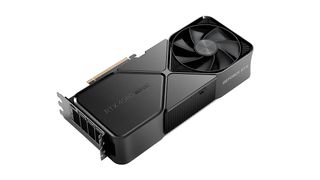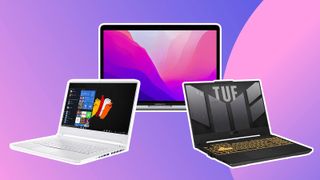
1. Best overall
2. Best Windows
3. Best budget
4. Best 17-inch
5. Most portable
6. Most powerful
7. Best dual-screen
How to choose
How we test
FAQs
Finding one of the best laptops for 3D modelling and rendering can seem like an uphill struggle. With the demands of high-end 3D software, you're going to need a powerful CPU and GPU, plenty of fast memory and lots of storage, which can mean plenty of time reading laptop specs to find one that's up to scratch.
We've been testing laptops for years, with our team of experts focusing on the creative application of the latest tech on the market. When reviewing, we look beyond specs and benchmarks, and always live and work with our review laptops for an extended period of time, to get a real feel for how they perform in everyday use. We run demanding creative software on them, test the limits of the multitasking load you can put on them, and assess what they're really like to work with.
Here is our round up of the best laptops for 3D modelling right now. For other high-specced and capable creative options, see our best laptops for graphic design, best laptops for animation, and the best monitors to go with them.
Quick list
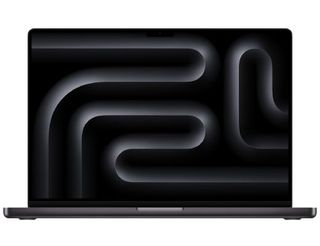
If you want a Mac, the MacBook M3 Max is the best option around. The chip will make light work of your 3D tasks, the battery life is impressive and the screen is glorious.
Read more below

A glasses-free 3D screen is only one of the unique and, frankly, awesome things about this laptop. Get the souped up Pro version for all the power you could ask for, though the standard one did pretty well in our tests, too.
Read more below
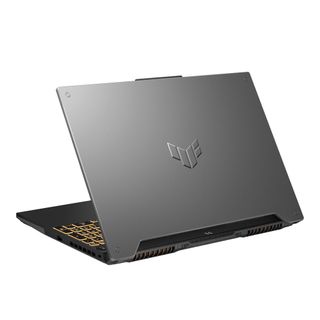
If price is a concern, this is an excellent balance of power and affordability. The 2022 model was good enough in our tests, but there is a 2023 upgrade if you're happy to spend a bit more. Speedy and capable.
Read more below
Best overall laptop for 3D modelling

Specifications
Reasons to buy
Reasons to avoid
For 3D artists working on a Mac there has never been a better time. The new MacBook Pro is a formidable machine, with lots of scope to spec suitable levels of RAM and storage for your projects. The M3 Max GPU is more than up to the task for rendered viewports, complex animations and high resolution texture sets. Just check your preferred software has a Mac-enabled version, and bear in mind the Mac/Windows software isn't always exactly the same.
We tested it on a range of 3D software, including Cinema 4D and Blender, and our benchmark tests showed it was a clear winner against the competition. Our reviewer even felt the MacBook Pro M3 Max is a genuine alternative for a powerful desktop computer. We found the running smooth and fluid, and appreciated that interactive rendering didn't show any lag – perfect for Redshift users.
The display is also top-notch, with an incredible 1,600 nits of peak brightness for HDR (the average nits is 500). The colours are super-accurate, with excellent contrast. And we didn't encounter any issues with the gloss display thanks to the brightness mentioned. We tested the 16-inch model, which provides the perfect size for optimum visual impact – but the laptop does also come in 14-inches if you'd rather something more portable.
Read our MacBook M3 Pro review for more.
Best Windows laptop for 3D modelling
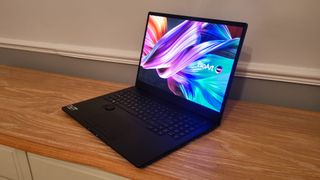
Specifications
Reasons to buy
Reasons to avoid
The Asus Pro Art Studiobook Pro OLED (H7604) is a thing of wonder. When we tested it we were blown away by its power and performance, and its glorious, glasses-free 3D screen. It's perfect for 3D modelling and rendering because it can handle demanding creative software easily, meaning no lag and speedy rendering times – as our benchmarks proved. There's a Pro option available with an Intel Xeon Workstation processor, which further soups up the performance considerably – but we tested the standard version.
The glasses-free 3D screen is a bonus, to be honest. We've all lived without seeing our creations in 3D on the screen, but why not, eh? Besides that feature, the 16-inch screen is glorious, with clear, crisp OLED technology.
We also loved the dial that sits at the bottom left of the keyboard, it's fully customisable and has separate settings for every app, so you can use it to adjust brush sizes, scroll through timelines etc depending on your needs.
Sure, the battery life isn't the best around (our tests put it at about 4 hours), but if you're not too worried about true portability the power benefits outweigh this issue. The keyboard is also unusual since Asus has crammed a full size keyboard into not-very-much space, but we felt it's something you'll get used to.
See our full Asus ProArt StudioBook 16 OLED review here.
Best budget laptop for 3D modelling

Specifications
Reasons to buy
Reasons to avoid
The ASUS TUF Gaming F15 laptop uses Asus' latest laptop tech to make a truly powerful machine. Outside, its redesigned chassis comes in Mecha or Jaeger variants. It features Intel's latest 13th Gen CPU with Nvidia RTX 40 Series Graphics. The 15.6-inch screen has a fairly standard refresh rate of 144Hz and full coverage of the DCI-P3 gamut, making it a great choice for creatives in the 3D world who are on a budget.
Our testing of the 2022 model found its processors can swiftly handle whatever is thrown at them and switching between demanding apps is easy. We found it a high-performing laptop and speedy enough for 3D modelling and rendering, even at this low price point. Of course, if you want something super-quick you'll need more power – but this is likely to cost more money. On balance, we think this is a great balance of price and performance.
See our full ASUS TUF Gaming F15 review of the 2022 edition. There's a newer model on offer (2023), which our research shows comes in at 20% more powerful in CPU-based tasks, but you can save more money by going for the previous model.
Best 17-inch laptop for 3D modelling

Specifications
Reasons to buy
Reasons to avoid
We think this 2022 model holds up as the best option for a 17-inch laptop today as it was designed with creatives in mind, and almost rivals a desktop machine in power. We found it to be a versatile workstation that's especially perfect for 3D artists due to its powerful performance, excellent screen – and its Nvidia Studio certification.
Our tests show that it gobbles up 3D tasks. We even ran Blender alongside browsing tabs and Netflix, and found there was no noticeable effect on efficiency, it was totally silent and no annoying lag. And the Blender benchmark came out close to a full desktop computer's capabilities.
There's a big choice of specs on offer, depending on your own workflow, and though it's not fully customisable Razer has offered a big range of options so you should find something to suit your needs. The battery life is pretty low (around 3 hours and 18 minutes) – kind of unsurprising given the power, but a shame nonetheless.
An 18-inch version has since been released, which outperforms the 17-inch, so if you want a truly massive screen, we strongly recommend that option.
See our full Razer Blade 17 review for more.
Most portable laptop for 3D modelling

Specifications
Reasons to buy
Reasons to avoid
An unassuming machine packed with power, this is truly portable option that rivals a workstation in its power. Our benchmarks tests shows it will handle most 3D tasks without issue – the specs we tested put it close to an MacBook Pro M2 Pro – and you can amp up the internals even further.
Even with all that power, the battery life is also way more impressive than others on the list, hence the portability crown. It lasted 12 hours while we used Photoshop, Cinema 4D, Netflix and other general tasks. That's almost four times the MSI Creator below (though it doesn't quite live up to the whack of power you get with that model).
We loved the display when we tested it, it's only 14-inches but we thought it felt bigger thanks to its clever design. Colours are glorious and accurate, too.
If you want a portable, powerful machine, this is the one for you. See our full Dell Precision 5470 review here.
Most powerful laptop for 3D modelling

Specifications
Reasons to buy
Reasons to avoid
There's no denying that the Creator Z17 HX Studio is an expensive laptop. The MSI is no slouch in the performance department – and its 16:10 display supports a stylus so you can create directly on screen. It's designed for creators, and our testing shows that it more than lives up to the label.
We found we could multitask whilst running creative apps with no issue – in fact our benchmarks put it close to desktop power. But getting this kind of power into a laptop chassis is no mean feat. The cooling system alone consists of three fans and five heatpipes, and MSI has to be congratulated for the engineering that’s gone on here.
That’s not a reason to buy it, though – the Creator Z17 HX Studio is for you if you want a whole lot of 3D modelling power that you can pick up and carry with you – just don’t travel too far away from a charger.
Read our MSI Creator Z17 review where we found this laptop to be good looking and adequately equipped but unfortunately not great in the battery department.
Best dual-screen laptop for 3D modelling
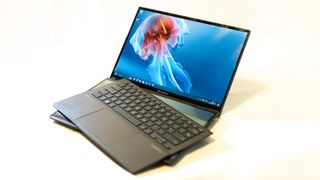
Specifications
Reasons to buy
Reasons to avoid
While the ASUS Zenbook Duo OLED loses some points on this list specifically due to only being fitted with Intel Arc Graphics instead of a 40-series NVIDIA card, the addition of an AI-boosted NPU means it gets much more out of the Intel Arc setup than any laptop got out of the previous-gen Intel Iris Xe Graphics.
Our testing showed it's not the most powerful machine out there (though the new Pro 2024 version is pretty impressive), so it won't fly through all 3D tasks, but if you want the dual screen and your workflow is more lightweight – or you want something generally super-useable – this is a good option.
Talking of usability, we loved how it's been designed for creativity so you can run 3D modelling software with your workspace on one of the 14-inch displays while keeping all your tools on the other one, no external monitor required. Both screens are touchscreens and can offer you a variety of inventive setups too.
Read our Asus Zenbook Duo OLED 2024 review where we tried very hard to find fault with this innovative laptop, and struggled to find any.
How we test laptops for 3D modelling
Creative Bloq's team of hardware experts bring with them many years of experience using, testing and benchmarking laptops with a focus on running creative applications. All the laptops in this guide have been tested by either using 3D-modelling software and rendering packages or benchmarked to make sure the CPU and GPU are capable of running 3D-modelling software without problems, as well as using other creative tools you'll use such as Adobe Creative Cloud applications and more. We run different benchmark tests on each laptop depending on its intended use by its maker, but the benchmarks we've run all the laptops in this guide through include the following:
• Cinebench R23/2024 - this assesses the performance of a computer's CPU and GPU using real-world 3D rendering tasks
• Handbrake - we use this free and open-source transcoder for digital video files to render a short 4K animated film, using the same file for all our tests
• Geekbench 5/6 - this tests the CPU's processing power, both by using a single core for a single task at a time as well as all the CPU's core to see its ability to multitask
• 3DMark - this assesses a laptop's ability to run 3D graphic rendering tasks
But perhaps more importantly than benchmarking, we evaluate machines in real-world scenarios, pushing them to the limit with multiple applications running to see how they perform in project-like conditions. Power, speed, flexibility, and what a laptop looks and feels like to use are all criteria in our reviewing process. We do much more than simply unpack a test unit, run some benchmarks and then pack it up again; we have lived and worked with all of the above laptops, running them in real-life scenarios and done projects relevant to this guide, otherwise we wouldn't recommend these models to you.
How to choose laptops for 3D modelling
In short, you're looking for as much power as possible when it comes to the hardware. You want the laptop to have a higher RAM and powerful CPU to make sure it can handle more intense 3D modelling applications like Blender and Maya. You also need to consider if you prefer working with Windows or macOS when purchasing. All of the above picks will be able to handle your 3D software of choice.
Windows laptops have also become a lot stronger in this arena lately, thanks to NVIDIA introducing RTX Studio, a platform designed to showcase laptops that meet the right criteria for serious creative work, meaning that they deliver great performance for anyone working with 3D, animation, graphic design, video and photo editing software. For a laptop to meet the RTX Studio performance bar, it needs to have, at the bare minimum, an Intel Core i7 CPU, 16GB RAM and 512GB SSD, plus GeForce RTX 2060, Quadro RTX 3000 or Titan RTX GPU, with a display resolution of at least 1080P. Look for that RTX Studio badge to ensure a laptop's going to be up 3D work; and of course another option is to look for gaming laptops, as the demands of running AAA video games can be on a par with those of 3D content creation.
The latest graphics cards to look out for are the NVIDIA GeForce RTX 40-series (especially 4070 and 4090), but a 30-series graphics card could offer a more palatable balance between value and performance if you're working on a narrower budget.
If you prefer to create on Apple hardware, things are a little simpler, as the MacBook Pro line packs plenty of power itself.
FAQ
What hardware is best for 3D modelling?
Why you can trust Creative Bloq
The CPU, GPU, RAM and screen size are all key factors when considering which laptop to buy for 3D modelling work. Here's a simple breakdown of what to look out for within each category.
CPU, or central processing unit
3D modelling and rendering requires a powerful processor that is 64-bit and multi-threaded. Intel i9 and Mac M3 CPUs are both powerful, professional multi-core processors that are ideal for 3D modelling work. If the majority of your rendering is carried out 'offline' and you deal primarily with large and complex scenes then you'll want a high performing CPU.
GPU, or graphics processing unit
Dedicated graphics cards are essential for 3D projects. It is possible to buy XPUs which are a blend of a CPU and a GPU but these will never perform as well as having two dedicated cards. NVIDIA GeForce cards are favoured by many artists but they do come at a cost, especially the newer 4000 series. If you want to render and tweak your models in real-time with textures, go for the best graphics card you can afford – it will pay its way when it comes to productivity
RAM, or random access memory
A laptop with at least 16GB is the minimum for a smooth working experience especially if you need to run multiple creative applications. Many creative-oriented laptops can be specced with 32 or 64GB, which is worth considering. Ensuring that it's DDR5 will help reduce power consumption while at the same time increasing bandwidth. Your graphics card will also be able to accommodate dedicated memory for rendering the display – again, the more the better.
Screen
This will largely be personal preference. I like as big a screen as possible, ideally a 17-inch for a laptop, to make those complex designs as easy to navigate as possible. If you're going to extend your display to other monitors though, you can get away with a much smaller screen size knowing that you won't be using it for this type of work.



